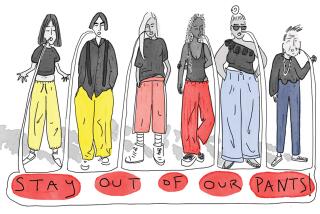Who Gets to Wear the Pants at the Office?
- Share via
Dear Fashion Police: I just accepted a position at a company that does not allow women to wear pantsuits. I was wondering what the legal rights would be in this case. I’d also like to find some good articles that promote pantsuits in order to better state my case to my boss.
--NOT SKIRTING THE ISSUE
For the record:
12:00 a.m. July 15, 2001 FOR THE RECORD
Los Angeles Times Sunday July 15, 2001 Home Edition Part A Part A Page 2 Zones Desk 2 inches; 55 words Type of Material: Correction
California Law--The Fashion Police column Friday on employees’ dress rights in the work place addressed only federal law. California law bars employers from banning pants on the basis of workers’ sex. There are exceptions, however. For further information, consult the California Department of Fair Employment and Housing at (800) 884-1684, or its Web site, https://www.dfeh.ca.gov.
Dear Not: We sympathize with your plight--we don’t know what we’d do if we couldn’t wear pants. Probably pitch a fit. We don’t recommend you do the same.
To find out what your legal rights are in this case, we spoke with Reginald Welch, communications director for the Equal Employment Opportunity Commission in Washington, D.C. Here’s the short version: It’s OK for an employer to require employees to wear uniforms or impose dress codes if they do so fairly and without discriminating on the basis of race, sex, color, religion, national origin, age or disability.
For example: Say the Widgets R Us company allows its male employees to wear appropriate business attire, but requires its female employees to wear uniforms. Why? Management believes women can be distracting if they wear short skirts, so having them wear uniforms, the company maintains, encourages a more serious work atmosphere. But men can wear anything they please. Now, that doesn’t seem fair, does it?
If the EEOC decides to investigate a dress code discrimination claim, Welch said, “We look for disparity of treatment. We [examine whether] a dress code is equally enforced among men and women with respect to the standard of burden they impose.”
Since each case is decided on its own merits, Welch couldn’t comment on your specific situation. He did say that if a business wants to promote a certain image through specific kinds of dress, that’s fine and dandy as long as everyone is held to those standards.
If women in your company are required to wear dresses or skirts and men are required to wear suits or jackets and ties, that may not constitute discrimination. However, if men are allowed to wear jeans and T-shirts, that is a disparity.
You do have the right to ask your employer the rationale behind the dress code, and if it’s comparable for men. If you’re not satisfied with the answer, you can file a claim with the EEOC, but it’s up to the agency whether to investigate. To find out more, visit the EEOC Web site at https://www.eeoc.gov.
If you want to make a case for wearing pantsuits, we suggest you wait a few months. As a new employee you need to prove yourself as an eager, capable worker before attempting to tweak existing policies.
To best make your case, you first need to know why the company has imposed this policy in the first place. Do bosses think women are not taken seriously as businesspeople if they’re not in a skirt? Do they believe the image of a woman in pants doesn’t convey enough formality?
If they seem open to discussion, you can point out that many businesses across the country, including traditional workplaces such as banks and law firms, have instituted more casual dress codes. Women in pants are a common and accepted sight in the workplace, and tailored pantsuits can project an image of professionalism and decorum just as skirts can. Let’s not forget that Hillary Clinton did most of her campaigning for her New York Senate seat wearing pants--and she won.
Casual versus formal is not the only dilemma facing businesses that have dress codes or are trying to establish them. Many young men and women are entering the work force with visible tattoos, body piercings and untraditional hairstyles and colors that challenge notions of what is appropriate. Some companies have an anything-goes policy; others claim such body decoration appears unprofessional and makes customers uneasy.
What do you think? We’d like to hear from employees, employers and customers or clients who have had to deal with this issue. If you’d like your comments included in a future column, please include your name and a way for us to contact you.
*
Write to Fashion Police, 202 W. 1st St., Los Angeles, CA 90012, fax to (213) 237-4888, or send e-mail to socalliving@latimes.com.
More to Read
Inside the business of entertainment
The Wide Shot brings you news, analysis and insights on everything from streaming wars to production — and what it all means for the future.
You may occasionally receive promotional content from the Los Angeles Times.










